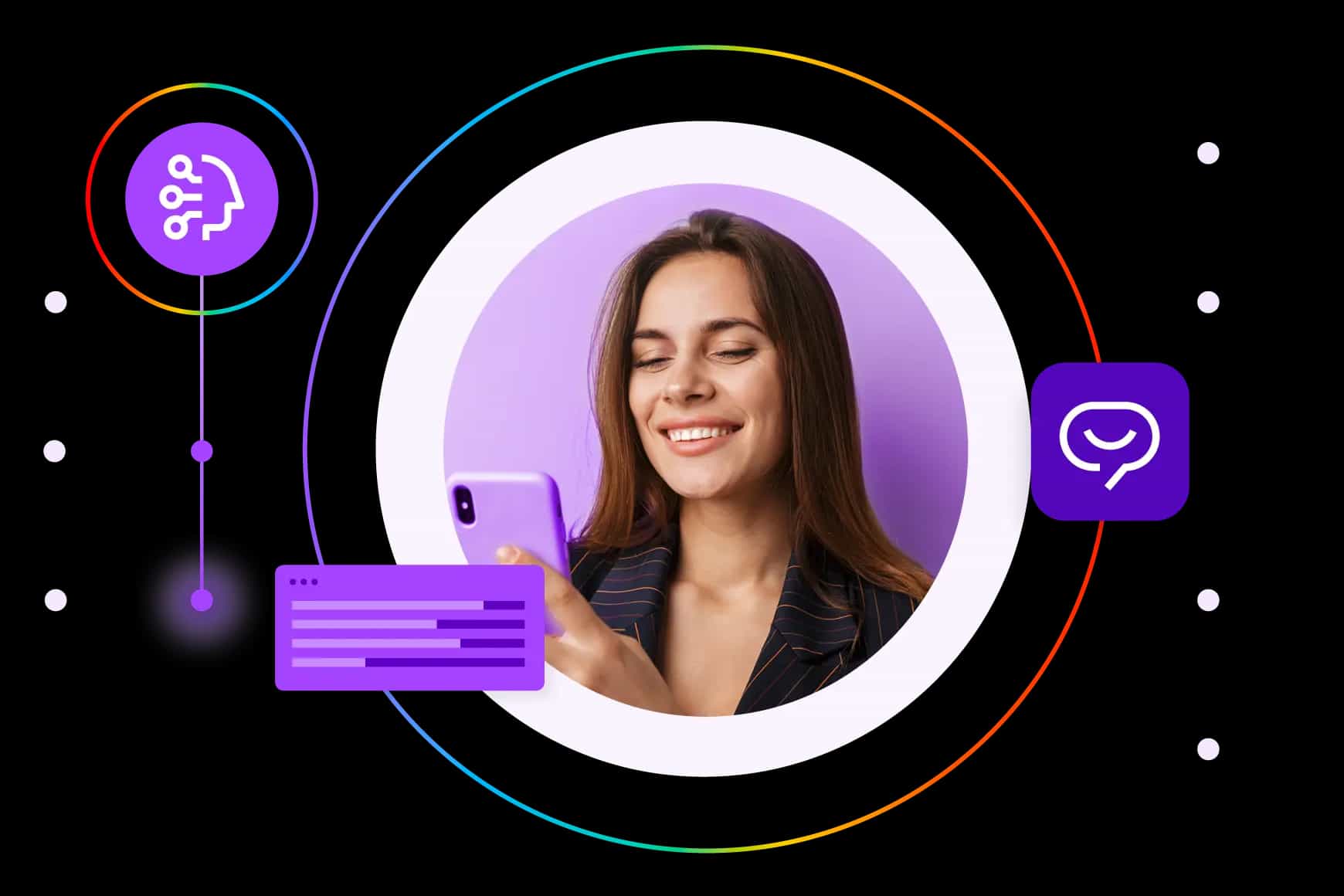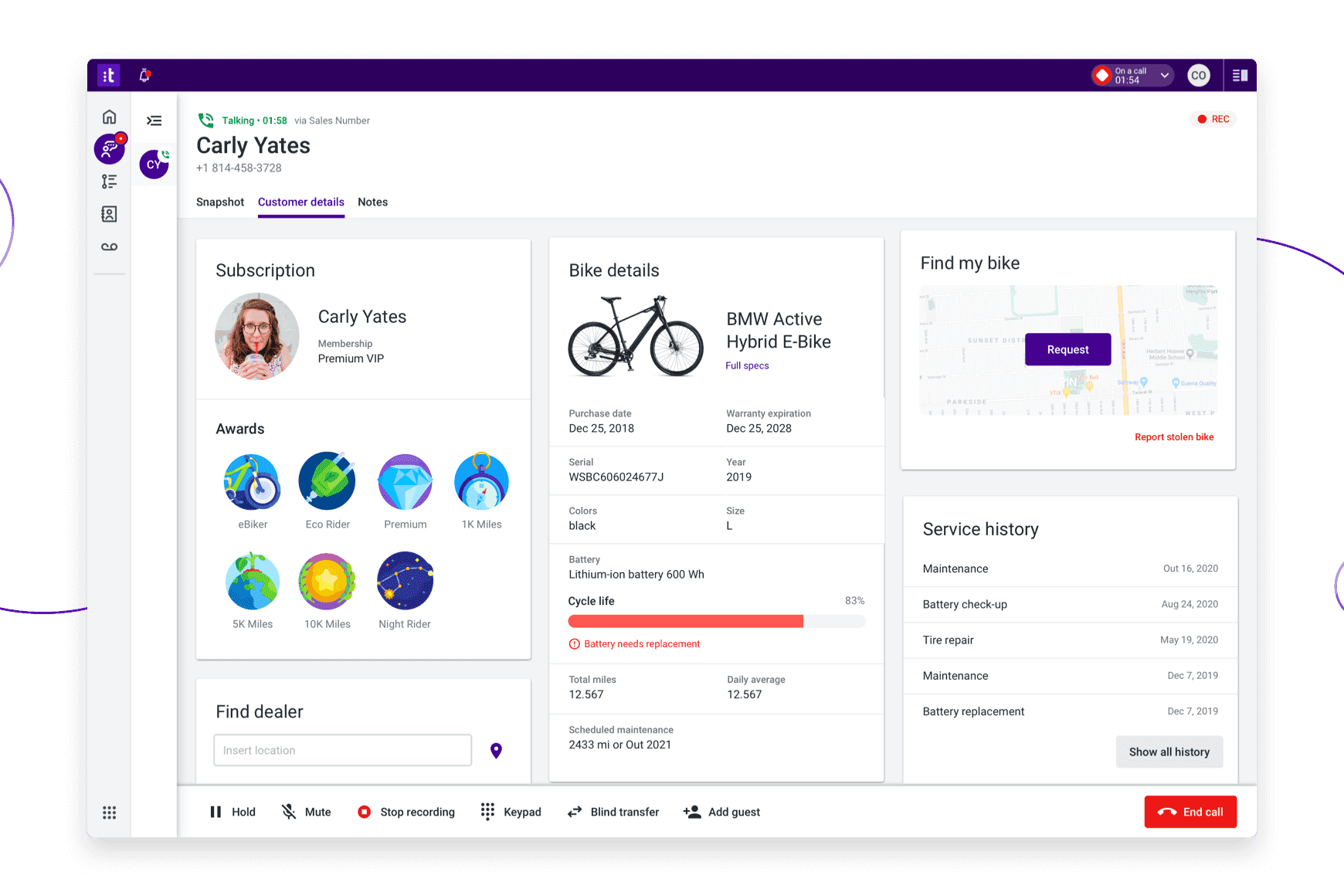How contact centers can improve the digital customer journey

By Celia Cerdeira
0 min read

Customers are increasingly turning to online platforms for their buying journeys. From research and comparison to purchase and post-purchase support, every customer interaction with a business can now happen online.
As a result, contact centers play a crucial role in facilitating these interactions and ensuring a seamless customer experience. Understanding and optimizing the digital customer journey allows contact centers to significantly enhance customer satisfaction, build long-term loyalty, and drive business growth.
In this article, we delve into:
Understanding the digital customer journey.
The digital customer journey has emerged as a crucial aspect of customer experience. It involves every interaction a customer has with a company through digital avenues—from the moment they first learn about your brand (awareness) to the post-purchase phase where the customer may seek support or make repeat purchases.
At its core, the digital customer journey is about how customers engage with your brand online. Whether browsing your website, engaging with your social media posts, reading your emails, or using your app, each touchpoint forms a part of their journey.
A seamless digital customer journey is no longer a luxury but a necessity in today’s digital-first world. According to research, 67% of customers prefer using self-service options over speaking with a company representative. This shift highlights the importance of a smooth digital customer journey and the need for easy-to-use, intuitive self-service tools that empower customers to find solutions on their own.
Despite its importance, many organizations still lack a thorough understanding of the digital customer journey. This lack of knowledge can lead to disjointed customer experiences, lower customer satisfaction, and lost opportunities for sales and growth.
For example, customers might be faced with confusing navigation, lack of information, or poor website performance. This can be frustrating and deter them from making a purchase. In fact, 76% of consumers would stop doing business with a brand after just one bad experience.
Understanding the digital customer journey is beneficial and essential for any contact center aiming to thrive in today’s competitive landscape. Mapping out and optimizing the digital customer journey allows businesses to create more meaningful interactions, foster customer loyalty, and drive business growth.
The stages of the digital customer journey.
Understanding and addressing the various stages of the digital customer journey can help contact centers tailor their strategies and solutions more effectively. Here’s a closer look at each stage:
Stage one: Awareness.
The awareness stage is where potential customers discover your brand or product. This could occur through various channels such as social media ads, search engine results, blog posts, online articles, or recommendations from friends.
For example, a person might become aware of a new fitness app through a targeted Instagram ad that highlights the app’s unique features and benefits. Or they might learn about a new local restaurant when a friend posts about their delicious meal on social media.
The key to the awareness stage is making a positive first impression that grabs attention and sparks interest in your brand or product. This could involve engaging content, a strong online presence, effective SEO strategies, or compelling advertising. Successfully capturing potential customers’ attention during this stage means businesses can guide them further along the digital customer journey toward consideration and purchase.
Stage two: Research.
This is where potential customers seek more information about your brand, products, or services after becoming aware of them. They might visit your website or social media pages, read blog posts or articles about your products, compare your offerings with competitors, and search online for customer reviews.
For instance, after discovering the new fitness app in the awareness stage, a potential customer might visit the app’s website to learn more about its features, pricing, and benefits. They could also read reviews from other users on the app store and compare them with other fitness apps available.
During this stage, it’s important to provide comprehensive, accurate, and easily accessible information about your offerings. This includes detailed product descriptions, FAQs, customer testimonials, and comparison charts. A user-friendly website design and intuitive navigation can also enhance the customer’s research experience. The goal is to provide all the necessary information for potential customers to decide whether to purchase.
Stage three: Evaluation.
In the evaluation stage, customers start assessing whether your product or service meets their specific needs. At this juncture, they might reach out to customer service with queries, request a demo, or even try out a free trial if available.
Taking the fitness app as an example, after conducting their research, the potential user might have a few questions about how certain features work or the terms of the subscription. They may contact customer support for clarification or take advantage of a free trial period to test the app’s functionality.
During the evaluation stage, businesses need to offer personalized and effective interactions. Quick response times, thorough answers, and friendly customer service can make all the difference in converting a potential customer into a paying one. Offering demos or free trials can also be a great way to showcase the value of your product or service, giving customers a first-hand experience of what they can expect.
Stage four: Purchase.
In the purchase stage, the customer finalizes their decision and completes the transaction.
In our fitness app example, once the user has completed their trial period, evaluated the features, and is satisfied with the app, they decide to subscribe to the premium version. They navigate to the in-app purchase section, choose their desired subscription plan, and complete payment.
You must provide a seamless, secure, and user-friendly checkout process during this stage. Ensure the steps to complete the purchase are clear and straightforward, with multiple payment options available for the user’s convenience. Any complications during this stage could result in cart abandonment and loss of a sale, while a smooth process can increase conversion rates.
Stage five: Post-purchase.
The post-purchase stage is the final phase of the digital consumer journey and includes all interactions after the sale, such as product usage, customer support, and follow-ups. It’s where businesses can transform a one-time customer into a loyal, repeat customer.
In the fitness app example, after the user has subscribed to the premium version, they start using the advanced features. They might need assistance understanding some functionalities, prompting them to contact customer support. The quality of support they receive, the helpfulness of user guides or tutorials, and the overall user experience will influence their satisfaction and likelihood to continue using the app.
In this stage, providing excellent customer service, proactive communication, and valuable resources can enhance customer satisfaction and foster loyalty. Follow-up emails checking the customer’s experience, offering helpful tips, or introducing them to new features can keep engagement high. This stage is crucial in building a long-term relationship with the customer and encouraging repeat purchases or subscriptions.
Five common pain points in the contact center digital customer journey.
Despite the growing importance of the digital customer journey, there are several common stumbling blocks to navigate in implementing it. These include:
1. Long wait times and no real-time assistance.
Customers expect quick and immediate responses, and any delay may result in customers abandoning the journey midway. Worse still, negative experiences can lead to poor word-of-mouth, affecting your brand reputation. So minimizing wait times and providing real-time assistance is vital for a smooth customer journey.
2. Limited support availability and self-service options.
Modern customers demand round-the-clock support. They expect to be able to solve their issues or find the information they need regardless of the time of day. Limited support availability and lack of self-service options can become significant roadblocks in the customer journey, leading to dissatisfaction and a decrease in customer loyalty.

WEBINAR
Supercharging your self-service with conversational AI
Learn how conversational AI can reduce administrative burdens for both customers and agents.
3. Repetitive information requests from agents.
One of the most frustrating customer experiences is having to repeat their issues multiple times to different agents. This wastes the customer’s time and creates a disjointed, frustrating experience for them. Streamlining information transfer between agents and departments can help alleviate this issue.
4. Lack of personalization.
Customers crave personalized experiences. They want to feel valued and understood by the brands they interact with. Generic, one-size-fits-all interactions can leave customers feeling undervalued and dissatisfied, negatively impacting their overall journey and perception of your brand.
5. Limited access to information and resources.
Customers expect to easily find the information they need to make decisions or resolve issues. When information or resources are hard to find or access, it leads to frustration and disrupts the seamless flow of the digital customer journey. Ensuring easy access to relevant information and resources can help enhance the customer experience.
The solution: digital customer journey mapping.
Digital customer journey mapping is a comprehensive solution, allowing contact centers to visualize the customer’s journey from their perspective, pinpointing pain points, and uncovering opportunities for improvement. Here’s a step-by-step guide:
1. Define customer personas.
Identify your typical customers. Consider demographic details, behavioral traits, preferences, motivations, and more. These personas will help you understand who your customers are and what they might expect from their interactions with your brand. For example:
“Busy Brenda” is a 35-year-old working mother of two young children. She lives in a suburban area and works full-time as an IT consultant. She values efficiency and convenience, loves a bargain, and shops online for convenience.
2. Identify digital customer touchpoints.
Next, map out all the places where customers interact with your contact center in the digital sphere. This could include mobile apps, websites, social media platforms, emails, live chats, etc. Understanding these touchpoints can help you optimize each for a better customer experience.
Brenda interacts with your brand through various platforms like your mobile app for shopping, social media for updates and promotions, and email for receiving newsletters and transaction confirmations.
3. Outline customer goals.
At each touchpoint, determine what your customers aim to achieve. Some might be looking for information about your products or services. Others may need support with a problem, while some could be ready to purchase. Knowing these goals can help you tailor your strategies to meet customer needs at every stage.
At each touchpoint, Brenda has different goals. On the mobile app, she aims to find products that suit her needs and make a purchase. On social media, she seeks to stay updated with the latest deals. Through emails, she expects to receive order confirmations and delivery updates.
4. Plot the digital customer journey.
Using a visual tool, map out each stage of the customer journey. Highlight potential pain points and areas where improvements can be made. This visual representation can help you better understand the customer’s journey and devise solutions to enhance their experience.
With Brenda’s persona and goals in mind, map out her journey from discovering your brand on social media, researching products on your app, making a purchase, and finally receiving after-sales service via email or live chat. Identify potential pain points like complex checkout processes or delayed customer support.
5. Test and optimize based on feedback.
Regularly test your customer journey to ensure it aligns with actual customer behavior. Use customer feedback and data analytics to refine and improve the journey continuously. Platforms like Talkdesk offer business intelligence features that can help you analyze customer journeys and provide actionable insights for enhancement.
After launching, monitor Brenda’s actual journey and gather feedback. If Brenda finds the checkout process lengthy, consider streamlining it. Regularly refine and improve the journey based on such feedback and behavioral data.
When you understand “Busy Brenda”, you can tailor each stage of the digital customer journey to meet her needs, enhancing her experience and fostering loyalty to your brand.
More solutions to improve the digital customer journey in contact centers.
To further enhance the digital customer journey, contact centers can leverage various strategies and technologies.
Implement an omnichannel engagement solution.
An omnichannel engagement solution provides a unified customer experience across all touchpoints. For instance, a customer might start their journey on a mobile app, switch to email, and then reach out via social media for support. An omnichannel solution ensures seamless transitions, maintaining consistency in the customer experience. This approach enhances the customer’s journey and fosters improved customer loyalty and satisfaction.
Enable AI-powered self-service options.
AI-powered chatbots or virtual agents can help customers resolve queries faster with a self-service experience, reducing wait times and enhancing customer satisfaction. For example, a customer might use a chatbot to find information about a product or resolve a minor issue, getting immediate assistance without waiting for a human agent. These tools provide 24/7 support, catering to modern customers’ expectations for instant help.

WEBINAR
5 ways to design virtual agents and chatbots to delight your customers
Get expert insights into the most common frustrations that customers face during conversations with virtual agents and learn how you can improve customer conversations with virtual agents.
Empower agents with comprehensive customer data.
When agents can access complete customer data, they can provide personalized and efficient service. For instance, an agent can see a customer’s previous interactions with the brand, preferences, and feedback with a CRM system. This information allows the agent to tailor their service to the customer’s needs, enhancing the digital customer journey. Talkdesk knowledge management features and integrations can further streamline this process.
Incorporating proactive customer engagement.
Proactive customer engagement involves reaching out to customers before they encounter an issue. For example, if a technical issue is detected that might affect a customer’s usage of your service, proactive engagement would involve contacting the customer to inform them of the issue and how you’re resolving it. This shows customers that you care about their experience and are committed to continuous improvement.
Talkdesk helps enterprise-level contact centers improve digital customer journeys.
Improving the digital customer journey is critical for any contact center. With solutions such as omnichannel engagement, AI-powered self-service options, comprehensive customer data for agents, and proactive customer engagement, Talkdesk provides a powerful cloud contact center platform for transforming the digital customer journey.
Leveraging these solutions allows contact centers to significantly enhance customer satisfaction, foster loyalty, and drive business growth. With its commitment to innovation and a keen understanding of the digital customer journey, Talkdesk is well-positioned to help transform your contact center experience.
To discover how Talkdesk can revolutionize your digital customer journey, request a demo of Talkdesk agent workspace solution today. Explore firsthand the power of exceptional customer experiences.

DEMO
See Talkdesk Agent Workspace in action
Talkdesk Agent Workspace allows your agents to connect with customers on any channel and elevate and continue conversations between channels while maintaining context throughout, creating a better experience for both your customers and your agents.
FAQs.
What are the five stages of the digital customer journey?
The five stages of the digital customer journey include awareness, where customers first learn about your brand or product; research, where they seek out more information about your offerings; evaluation, where they assess whether your product or service meets their specific needs; purchase, where they decide to buy your product or service; and post-purchase, which involves all interactions after the sale such as customer support and follow-up communications.
How do you create a digital customer journey map?
Creating a digital customer journey map involves understanding your customer’s behaviors, needs, and experiences at each journey stage. Start with defining the stages of the journey (awareness, research, evaluation, purchase, post-purchase). Then, for each stage, identify the customer’s goals, their actions to achieve them, the channels they use, and any potential pain points they may encounter. Use this information to visually represent the customer’s journey, which can help you identify opportunities to enhance their experience and build stronger relationships.
What is digital customer journey mapping?
Digital customer journey mapping is a strategic process that businesses use to better understand their customers’ online experiences with their brand or products. It starts with defining customer personas and then identifying each digital touchpoint where customers interact with your business online. After that, the goals that customers aim to achieve at each of these touchpoints are outlined, and then these elements are brought together to plot the digital customer journey, creating a comprehensive visual representation of the customer’s experience from initial contact through to achieving their goal.





